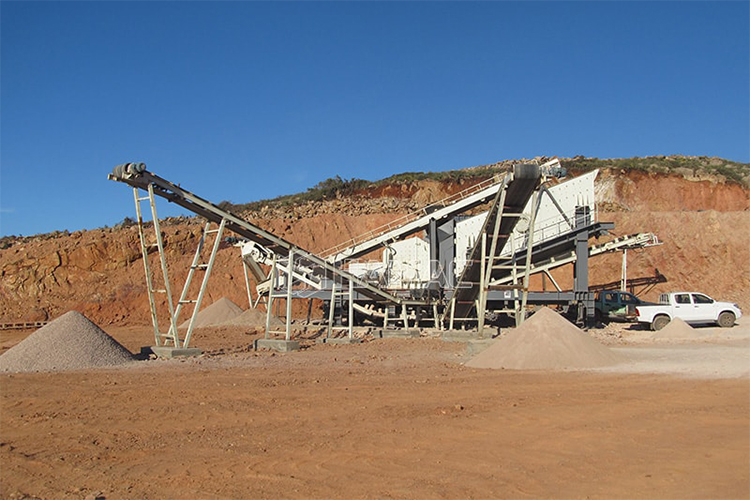A 300 tons per hour (tph) sand making line is a comprehensive system designed to transform raw materials like granite, limestone, river pebbles, or basalt into high-quality construction sand. This production line integrates multiple stages, from material feeding to final sand screening, ensuring consistent particle size, cubical shape, and low impurity content—critical for concrete, asphalt, and building projects. Below is a detailed breakdown of its working flow:
1. Raw Material Feeding
The process begins with feeding raw materials into the line. A vibrating feeder is used to uniformly transport large chunks of material (up to 500mm in diameter) from the storage hopper to the primary crusher. The vibrating feeder’s adjustable speed ensures a steady flow, preventing overload in subsequent stages. For materials with high moisture content, optional dewatering screens can be added to reduce clogging risks.
2. Primary Crushing
Raw materials first undergo primary crushing to reduce large boulders into smaller, manageable pieces. A jaw crusher PE 900×1200 or European type C series jaw crusher C125 is typically used here, as it excels at breaking hard, abrasive materials like granite. The jaw crusher applies compressive force to crush materials into particles of 50–150mm, suitable for secondary processing. This stage is critical for protecting downstream equipment from excessive wear.
3. Secondary Crushing (Intermediate Crushing)
After primary crushing, the material is conveyed to a cone crusher for secondary crushing. Cone crushers are ideal for reducing the 50–150mm particles to 10–30mm, achieving a finer, more uniform size. Their high crushing efficiency and ability to handle hard materials make them essential for producing sand with consistent gradation. For softer materials like limestone, an impact crusher may replace the cone crusher to enhance particle shape.
4. Sand Making (Final Crushing)
The 10–30mm crushed material is then fed into a vertical shaft impact (VSI) crusher—the core of the sand making line. VSI crushers use high-speed rotor rotation to accelerate material, creating impact between particles (autogenous crushing) or against anvils. This process shapes the particles into cubical sand with excellent grain size distribution (typically 0–5mm, 5–10mm, and 10–20mm). The VSI crusher’s adjustable rotor speed allows operators to control sand fineness, meeting specific project requirements.
5. Screening and Classification
After sand making, the mixture of sand and oversize particles is sent to a vibrating screen. The screen separates the material into multiple grades:
Qualified sand: Particles meeting the target size (e.g., 0–5mm, 5–10mm) are conveyed to the finished product pile.
Return material: Oversize particles (>20mm) are recycled back to the VSI crusher for reprocessing, ensuring no waste and consistent quality.
For projects requiring dry sand, a sand washing machine can be integrated after screening to remove dust and impurities, improving sand cleanliness.
6. Conveying and Storage
Throughout the line, belt conveyors transport materials between stages, with adjustable speeds to match production. Finished sand is stored in silos or stockpiles, ready for loading and transportation. Some lines include automated stacking systems to organize sand by grade, simplifying loading and inventory management.
Key Advantages of a 300 tph Sand Making Line
High Efficiency: With a 300 tph capacity, it meets large-scale construction demands, producing over 2,000 tons of sand daily (8-hour shift).
Quality Sand: VSI crushers ensure cubical particles with low flakiness, ideal for high-strength concrete.
Flexibility: Adaptable to various raw materials (granite, limestone, etc.) and adjustable sand grades.
Automation: Equipped with PLC control systems for real-time monitoring of production data (e.g., output, power consumption), reducing manual intervention.
This working flow ensures that a 300 tph sand making line delivers high-quality sand efficiently, making it a cornerstone of modern construction, infrastructure, and mining projects. Whether for commercial sand supply or on-site project use, it balances productivity, quality, and cost-effectiveness. The equipment used in the above sand making production line configuration plan is produced and sold by KLZ Machinery Equipment Manufacturer. KLZ Machinery is a manufacturer specializing in the production of stone crushing equipment. It has many years of technical and sales experience and the quality of the equipment produced is guaranteed. If you are interested in our limestone crushing equipment, you can consult online to get professional solutions and price list now.

